-
info@aaanimalcontrol.com
Call us for help in your town
Humane Wildlife Education
Raccoons in the Attic - How to Get Rid of Them
Read the below tutorial with step-by-step photograph instructions for information about raccoons and how to get them out of an attic. It's not always a simple task - it usually requires these 4 steps to get raccoons out of an attic:
- 1) Physical removal of the nest of baby raccoons
- 2) (Humane) trapping or exclusion of adult raccoons
- 3) Repairs to the entry points
- 4) Cleanup of raccoon feces and waste.
Raccoons often choose to make their home inside
of people's attics. An attic provides a safe
shelter for a raccoon, and usually meets all of
their living requirements: shelter from the
elements, safety from predators, and oftentimes
close proximity to food - such as garbage cans or
pet food.
If you have a raccoon in the attic, take note of
the time of year. If it is springtime, say Feb -
June, then there's a very good chance that the
raccoon is actually a mother with a litter of
young pups up in the attic. Female raccoons love
to raise their young in a warm, safe attic. You
CANNOT just trap the female outside if you don't
get the pups. They will suffer and starve to
death, and then they will decay and create a large
odor. And the desperate female, once relocated,
will do anything to get back to the young, and
possibly die in the process.
Most people first call me when they hear the
noise the animals create. A large animal like a
raccoon can cause quite a bit of racket climbing
around and digging in the attic. A litter of young
will also often squeal for their mom, making a
loud noise. Some homes are less prone to sound,
and the occupants learn about their raccoon
problem when they physically spot the animal, a
frequent occurrence with a busy mother raccoon.
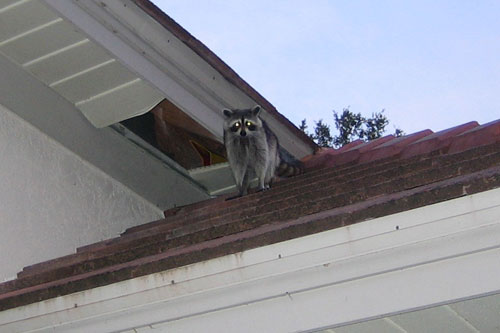 Here we see the culprit - a female
raccoon, on the roof near the hole in the
soffit that it tore open. Raccoons have no
problems climbing on to a roof, and once
there, they can easily tear a hole open to
gain access.
Here we see the culprit - a female
raccoon, on the roof near the hole in the
soffit that it tore open. Raccoons have no
problems climbing on to a roof, and once
there, they can easily tear a hole open to
gain access.
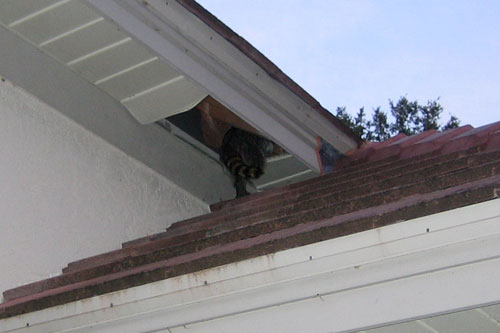 Sure enough, it crawls right inside.
Sure enough, it crawls right inside.
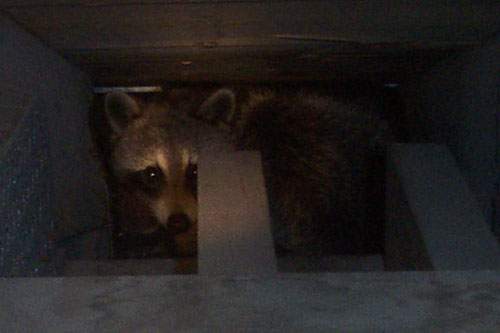 Once inside the attic, I search for the
adult. She usually hides down in the
eaves, and I can't catch her. Sometimes
I'm able to use a snare pole and grab
her and remove her, and sometimes I'm
able to scare her out of the attic and
into a waiting trap mounted at the hole,
but sometimes she gets away and I have
to use other methods.
Once inside the attic, I search for the
adult. She usually hides down in the
eaves, and I can't catch her. Sometimes
I'm able to use a snare pole and grab
her and remove her, and sometimes I'm
able to scare her out of the attic and
into a waiting trap mounted at the hole,
but sometimes she gets away and I have
to use other methods.
 I search until I find the litter of
pups. In this case, down a column at the
edge of the attic. Finding the young can
often be very difficult, and it takes a
lot of patience and hard work up in a
hot attic. If they make noise, it's
easy. If mama racoon has stashed the
baby raccoons down a wall and told them
to be quiet, it can be very hard to find
them, but it must be done.
I search until I find the litter of
pups. In this case, down a column at the
edge of the attic. Finding the young can
often be very difficult, and it takes a
lot of patience and hard work up in a
hot attic. If they make noise, it's
easy. If mama racoon has stashed the
baby raccoons down a wall and told them
to be quiet, it can be very hard to find
them, but it must be done.
 I remove the young from the attic. It's
very hot in Florida attics! I carry them
as their mom would, by the scruff of the
neck. This keeps them quiet. Some baby
raccoons can be very agressive, and will
lunge and bite. Others are docile and
easy. In the event
that you wish to hire us, you
may want to see how
much does raccoon removal cost?
I remove the young from the attic. It's
very hot in Florida attics! I carry them
as their mom would, by the scruff of the
neck. This keeps them quiet. Some baby
raccoons can be very agressive, and will
lunge and bite. Others are docile and
easy. In the event
that you wish to hire us, you
may want to see how
much does raccoon removal cost?
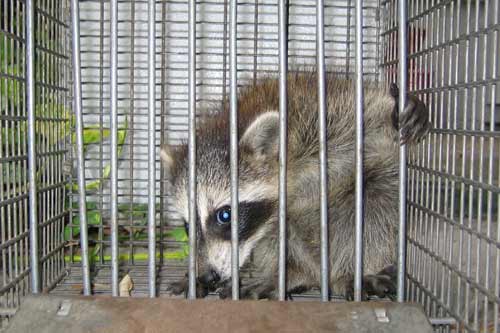 I set the juveniles in the back of
traps, to try to catch the mom. This is
the absolute best "bait" to use to trap
a female raccoon. She will do anything
to get to her babies, so even if she's
shy of a trap, she'll still go in. It's
important to set this correctly. If the
trap goes off, from the mother working
the outside, or the baby setting it off,
then the female will go crazy trying to
get in, and will likely cause some
damage, maybe to herself. This type of
set takes a lot of experience. For more information read my raccoon trapping guide.
I set the juveniles in the back of
traps, to try to catch the mom. This is
the absolute best "bait" to use to trap
a female raccoon. She will do anything
to get to her babies, so even if she's
shy of a trap, she'll still go in. It's
important to set this correctly. If the
trap goes off, from the mother working
the outside, or the baby setting it off,
then the female will go crazy trying to
get in, and will likely cause some
damage, maybe to herself. This type of
set takes a lot of experience. For more information read my raccoon trapping guide.
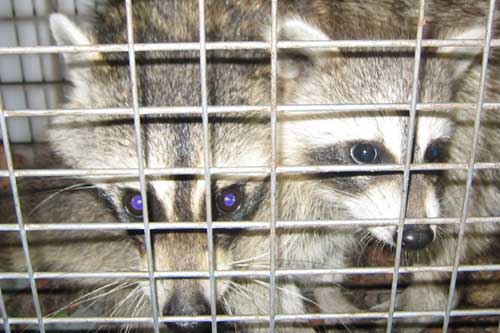 Sure enough, the mom raccoon enters the
trap, lured in by its own baby. Even
when faced with a larger animal like a
human, the mother raccoon is always
protective of its young first.
Sure enough, the mom raccoon enters the
trap, lured in by its own baby. Even
when faced with a larger animal like a
human, the mother raccoon is always
protective of its young first.
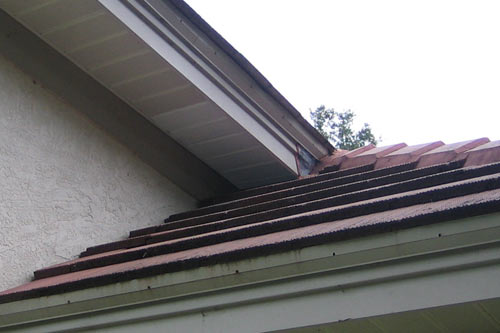 After I have the mom and all the babies
out of the attic, I seal the entry
points. This is a vital step in the
process. If you leave the holes open,
new wildlife will surely enter. No job
is complete until all the holes are
sealed shut.
After I have the mom and all the babies
out of the attic, I seal the entry
points. This is a vital step in the
process. If you leave the holes open,
new wildlife will surely enter. No job
is complete until all the holes are
sealed shut.
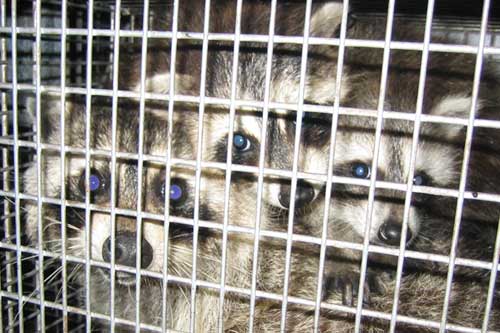 I make sure to keep mom and all the
young together. I then relocate them
together to a nature preserve far
outside the city. It may be hard for
them to survive once evicted from their
home, but mother raccoons are very
resourcful. If the mother and babies
cannot be kept together, I bring the
young to a licensed wildlife
rehabilitation specialist.
I make sure to keep mom and all the
young together. I then relocate them
together to a nature preserve far
outside the city. It may be hard for
them to survive once evicted from their
home, but mother raccoons are very
resourcful. If the mother and babies
cannot be kept together, I bring the
young to a licensed wildlife
rehabilitation specialist.
Raccoons can cause quite a bit of damage when they
live in an attic. Please see my
raccoon attic damage page for more photos
of raccoon damage. Not only do they urinate and
defecate in the attic, but they can bring in a
host of parasites (fleas, ticks, mites, and
lice) and diseases (raccoon roundworm,
leptospirosis, etc). They often tear apart
ductwork, rip insulation off of pipes, gnaw on
wires, and trample down the insulation, lowering
its R-value effectiveness. They also tear open
holes to gain access to the attic in the first
place. I highly recommend attic
cleanup and decontamination services if
you've had a raccoon living in your attic.
Summary of the 7 steps to get rid of raccoons in the attic:
- Before you start, be aware that when raccoons live in your attic, it is almost always a female raccoon with a litter of babies. Be sure to remove the babies as well as the adult.
- NEVER EVER simply set a trap outside. If you catch the mother raccoon and take her away, this will leave her babies up in the attic to starve to death, and cause an odor problem for you. This is very cruel.
- If you, or a trapping company, catches the mother outside, you MUST go in the attic to get her young. If your trapper is lazy and claims there are no young, that guy is a heartless asshole.
- First, inspect your house to identify the entry points. The entry point is usually on the roof or eaves, such as a roof vent or where an eave meets the roof.
- Second, listen to the noises in your attic or ceiling. Listen to where the raccoon spends its time, and listen for vocal cries and chattering from baby raccoons.
- Third, enter the attic. You might see the female raccoon with her litter of babies. Or maybe she'll quietly exit the attic or go down a wall. Sit still for up to 20 mintues, listening for the baby raccoons.
- Fourth, you can sometimes intimidate a female and it will leave on its own with the young. Accomplish this via physical harassment and the use of raccoon eviction fluid.
- Fifth, if that doesn't work, remove the litter of baby raccoons by hand, and place in a pillow case, and remove them from the attic. Beware the potentially aggressive mother raccoon.
- Sixth, use the baby raccoons as "live bait" to lure the mother into a cage trap, in the back of a trap with a trap divider mechanism. Use a large sturdy steel cage trap, at least 12"x12"x32". Always set the trap in the shade, to prevent overheating. Make sure the trap is on a solid, level surface.
- Seventh, after you trap the mother, remove the divider so she can be with her young, and relocate the group at least ten miles away from your house. The mother will run away at first, but leave the young on the ground and she will return for them.
If you have raccoons in your attic, you really
should hire a professional wildlife trapper to
take care of the problem. It's not easy to get rid
of raccoons in the attic. There's no magic spray
or ultrasonic sound device or any gimmick that
will make them leave. They need to be trapped and
removed. It's not work for amateurs or
do-it-yourselfers. Many people will just buy a
trap and set it on the ground and never catch
anything, or catch stray cats, opossums, and other
non-target animals. Or worse, some crummy
companies or so-called handy homeowners will set a
trap or two on the ground, and actually catch the
mom raccoon, and get rid of her - only to leave
the babies up in the attic to squeal and suffer
and die and then decompose and stink. Please don't
try to do this yourself or hire a cut-rate lazy
trapper who won't go into the attic and get the
young. The job has to be done right! Also, keep in
mind that they sometimes live in the chimney as
well. Read How
to Remove a Wild Animal in the Chimney. I
also have a story of a particular raccoon trapping
job on my raccoon in
house page.
Read more about raccoons:
How to get a raccoon out of a tree
Why do raccoons tear up sod? How to stop it
What are raccoons scared of?
How to scare a raccoon away
How To Get Rid Of Raccoons Without Killing Them
Raccoons in New York City
What kind of noises and sounds do raccoons make when they live in your house?
How to make a raccoon trap
How to hunt raccoons
Do female raccoons make good mothers?
How to get free raccoon removal
Do raccoons wash their food?
The Fastest Way To Get Rid Of Raccoons
 Click for my raccoon removal photo gallery.
Click for my raccoon removal photo gallery.
Over 60 photographs of actual raccoon trapping and removal jobs I've done.
 Visit my awesome opossum trapping blog!
Visit my awesome opossum trapping blog!
Over 25 examples of specific raccoon control jobs I've done. Get ideas!


















